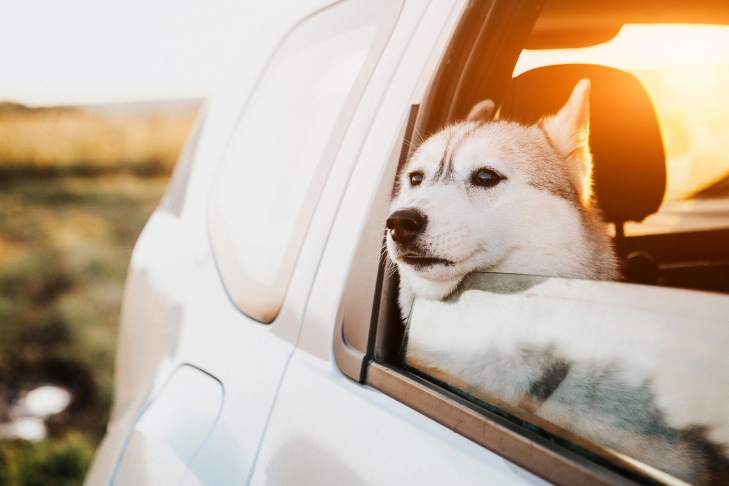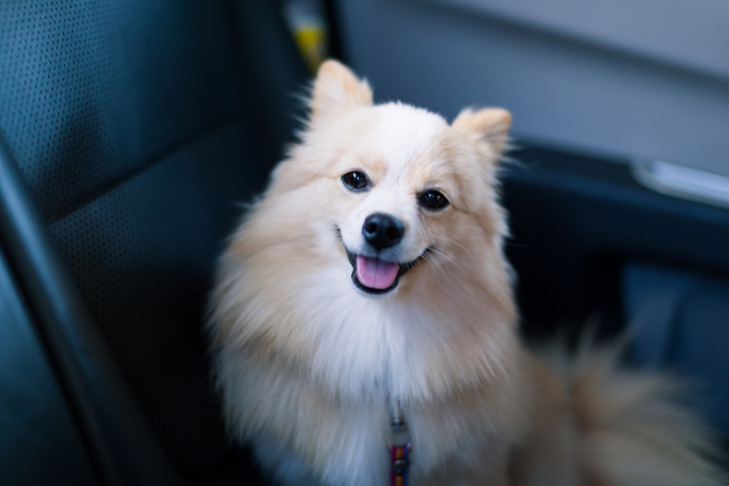Car Sickness in Dogs: Signs, Causes, Prevention, and Treatment

By Elaine Waldorf Gewirtz
All dogs love going for a good car ride, right? Head out the window and ears flying in the wind seems like every dog’s dream come true. Well, not always. Some puppies and young dogs get carsick just five minutes after leaving home. Others only need to look at a car to feel queasy.
The motion, stress, and excitement of a moving adventure outside the house is a common canine fear that can trigger tummy trouble. Luckily, most puppies and dogs will adapt to the experience more often they go for rides.
Car Sick Signs to Look For
How can you tell if your canine BFF experiences motion sickness? Observe your dog for these potential signs:
- Head hanging down
- Ears pinned back
- Wide-open eyes
- Yawning
- Excessive drooling
- Panting
- Constant lip-licking
- Lips pulled back
- Tight facial muscles
- Repeated swallowing
- Afraid to move
- Body position crouched down low to the ground
- Tail down or tucked between legs
- Lethargy
- Trembling/shaking
- Crying in distress
- Whining
- Gagging
- Vomiting
Any breed, size, age, or gender can feel sick to the stomach.
What Causes Motion Sickness in Dogs?
Two reasons—physical or psychological, may explain the queasy feeling during travel. Once you understand why your dog may be experiencing motion sickness, you can take steps in many cases to help prevent it.
Like some young children, motion sickness in puppies and young dogs is due to the sense of balance as inner ear structures are not yet fully developed. Many pups will outgrow travel sickness, but if they feel nauseous on their first car rides, they will connect the feeling to future journeys. Motion sickness may improve with age.
Stress also contributes to an upset stomach. If the puppy’s first car trip resulted in a fearful visit to the veterinarian for an examination and vaccines, the pup would associate the experience the next time a trip comes up. Expect that getting into the car may involve a struggle, even for a fun outing.
The car’s strange odor, engine sound, and vibration can be frightening. Add seeing objects flying past the windows at a scary speed, and it’s no wonder a dog is reluctant to hop into the car.
If the dog rode in a vehicle hit by another car, the accident would create a long-lasting fear that it will happen again.

How to Prevent Car Sickness in Dogs
You can train your dog to take car rides in stride. To make the ride-along adventure more comfortable, try these tips:
- Hold off feeding your dog for 12 hours before hitting the streets. An empty stomach has less chance of getting upset. It’s OK to give water.
- If you have another vehicle, take your dog for a test drive in that one. The different car odors may change his prior negative association.
- Use an auto safety restraint, such as a dog harness with the seat belt, a dog car seat, or a travel crate. These will help stabilize the dog during sudden stops and ward off nausea.
- Bring your dog’s favorite dog blanket or toy along for your dog to feel secure.
Build your dog’s positive association with road trips by repeating separate short sessions:
- Stand next to the car and give your dog a small treat.
- On a leash, lure your dog inside with a happy voice to encourage the dog to enter. Add a treat or a favorite toy.
- Open the car doors and spend some time petting and talking to your dog. The air prevents the feeling of being trapped. Don’t turn on the engine.
- With your dog in the car, turn on the engine for a minute or so but don’t go anywhere. Turn it off, wait a few minutes and turn it on again.
- Drive down the driveway or around the block when your dog seems calm and relaxed with the engine running.
- Repeat short distances and add a fun destination, such as a walk in the park, the beach, or the drive-thru for a small treat.
- Keep the car windows down at least halfway to give your dog fresh air when riding in the car.
- Let your dog ride in the middle seat of the back, facing forward.
Remain patient with the process. Your dog needs time to realize that car rides aren’t so terrifying.
How to Treat Car Sickness in Dogs
Use extra support tools like pet CBD. You can also ask your veterinarian to recommend medication for nausea or stress.
Give your dog CBD hemp oil an hour before you plan to leave. This helps calm your dog down.
With time and patience, you can alleviate your dog’s dislike of car travel. Desensitizing your dog to the car will let your four-footed friend enjoy fun outings and make your life much easier.


